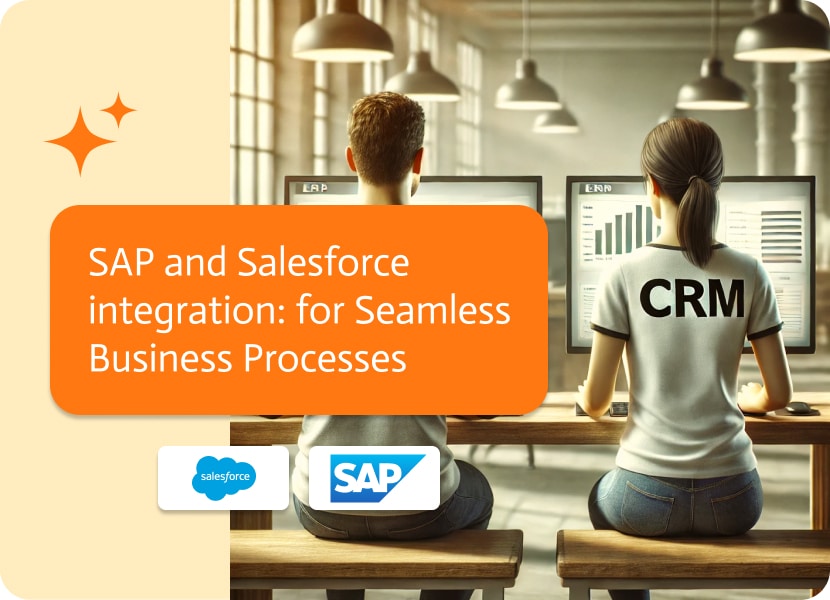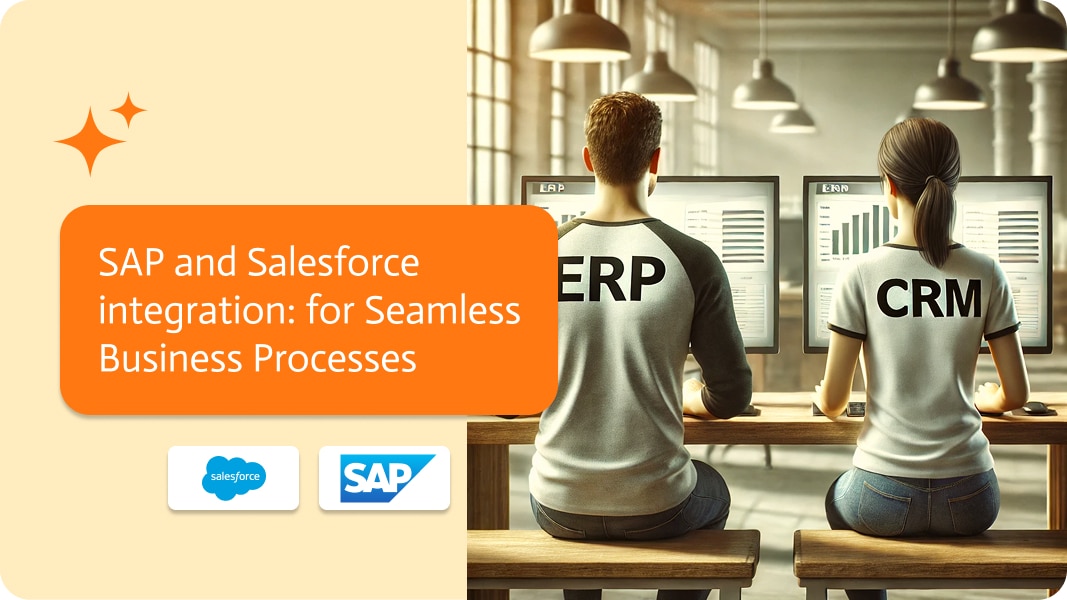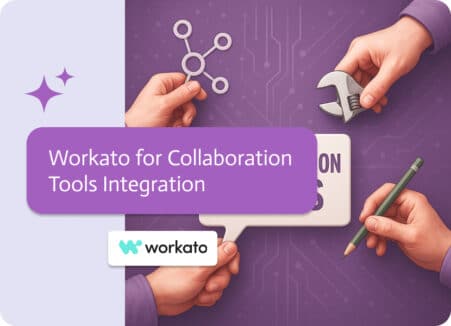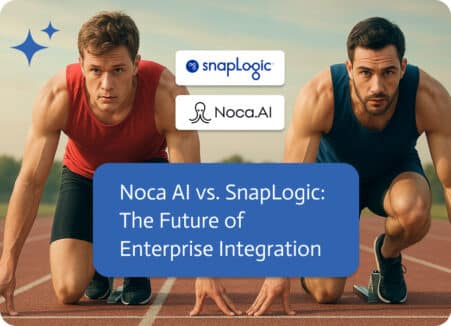

SAP and Salesforce integration: for Seamless Business Processes
Integrating Salesforce, the world’s leading CRM platform, with SAP, a powerful ERP system, allows organizations to streamline data exchange and optimize workflows across departments. The Sap and Salesforce integration enables real-time synchronization of customer, sales, and financial data, which improves operational efficiency and delivers better customer experiences. In a world where businesses increasingly rely on interconnected systems, seamless data integration becomes a key driver of success.
In this article, we’ll explore the benefits of integrating Salesforce and SAP, provide in-depth use cases, and discuss how to set up the integration using an iPaaS solution. We’ll also look at the common challenges businesses face during integration and share best practices for a successful implementation.
Why Salesforce SAP Integration is Critical for Businesses
Salesforce excels at managing customer relationships, while SAP handles core business functions like finance, supply chain management, and production. When these systems work together, organizations can:
- Eliminate data silos: Ensure accurate, up-to-date data is accessible across both CRM and ERP systems, enhancing decision-making and collaboration.
- Automate workflows: By integrating key processes like sales and order management, companies can reduce manual tasks and improve productivity.
- Enable real-time data access: Integrating Salesforce and SAP gives teams real-time visibility into important information, from customer orders to inventory levels.
This integration allows businesses to centralize operations and deliver seamless customer experiences.
Why Choose iPaaS for Salesforce SAP Integration?
When it comes to integrating Salesforce and SAP, companies generally have two choices: custom integrations or Integration Platform as a Service (iPaaS) solutions such as Noca AI. While custom development allows for deep customization, it is complex, time-consuming, and requires significant technical expertise. iPaaS solutions, on the other hand, offer a more flexible, scalable, and user-friendly alternative.
Why Many Companies Opt for iPaaS:
- Ease of setup: iPaaS platforms offer pre-built connectors for both Salesforce and SAP, drastically reducing the time and effort required to establish a connection.
- No-code or low-code environments: iPaaS platforms often provide drag-and-drop interfaces that enable non-technical users to manage integrations without the need for coding skills.
- Scalability: iPaaS platforms are built to grow with your business, allowing you to easily add more integrations as your needs evolve.
- Real-time synchronization: Many iPaaS solutions offer real-time data syncing, ensuring that data across Salesforce and SAP is always accurate and up to date.
By opting for an iPaaS solution, businesses avoid the complexities of custom development while benefiting from faster implementation and easier management of integrations.
Use Cases for Maximizing the Value of Salesforce SAP Integration
The integration of Salesforce and SAP goes far beyond basic data synchronization. When implemented correctly, it transforms how departments across the organization work together. Below are extended and detailed use cases demonstrating the power of Salesforce SAP integration.
1. Opportunity-to-Cash Process Automation
One of the most impactful use cases of Salesforce SAP integration is the opportunity-to-cash process, which involves automating the flow of data from the moment a sales opportunity is created in Salesforce through to payment collection in SAP.
Imagine a manufacturing company where sales reps use Salesforce integration to track potential deals. When an opportunity is marked as “closed-won,” the integration automatically generates a sales order in SAP, initiating the order fulfillment process. SAP then manages the financial aspects—such as invoicing and payment collection—while Salesforce keeps sales teams updated on the order status.
This level of automation eliminates the need for manual data entry, reducing errors and speeding up the sales cycle. By connecting sales with finance and logistics, the company can ensure that orders are fulfilled quickly, customers are billed accurately, and sales reps have full visibility into the entire process.
2. Real-Time Inventory Management
A key challenge for many sales teams is having access to accurate inventory levels when quoting customers. Without real-time access to SAP’s inventory data, sales reps often rely on outdated or estimated stock levels, which can lead to over-promising delivery dates or missing out on sales opportunities due to inaccurate stock assessments.
By integrating Salesforce with SAP’s inventory management system, sales reps can view real-time stock availability directly within Salesforce when creating quotes. For example, a company that sells electronics can sync its Salesforce quoting system with SAP’s inventory data. This integration allows sales reps to see the exact number of units available at the time of quoting, enabling them to offer more accurate delivery timelines and improve customer satisfaction.
In addition to increasing sales efficiency, real-time inventory access helps the company manage stock more effectively, preventing stockouts and optimizing production planning based on incoming orders.
3. Customer Support and Case Management
Customer service teams often require access to both CRM data and ERP data to resolve customer issues efficiently. For instance, when a customer contacts support with a product issue, the agent might need to check the order details in Salesforce and then look up shipment or warranty information in SAP. Without integration, this process can involve switching between multiple systems, leading to delays and a disjointed customer experience.
With Salesforce SAP integration, customer support agents can view the entire history of a customer’s interactions—including sales orders, shipments, warranties, and service cases—within Salesforce. When a customer inquires about the status of a product shipment, the agent can retrieve real-time data from SAP without leaving Salesforce. This streamlined access to both CRM and ERP data enables agents to resolve issues faster, improving the overall customer experience.
Moreover, the integration allows for automated case escalation. For example, if a customer submits a high-priority service case in Salesforce, SAP can automatically trigger workflows to allocate the necessary resources—whether it’s parts, labor, or service teams—to resolve the issue.
4. Financial Reconciliation and Forecasting
Integrating Salesforce and SAP allows finance teams to reconcile revenue data more efficiently and perform more accurate financial forecasting. By connecting Salesforce opportunities and SAP’s financial data, companies can track sales performance against financial goals in real time.
For instance, once a deal is closed in Salesforce, the related revenue data can be automatically synchronized with SAP’s finance module. This ensures that financial records are always up to date, and the finance team can monitor cash flow, accounts receivable, and revenue forecasts without waiting for manual updates.
Additionally, integrating Salesforce pipeline data with SAP enables more precise revenue forecasting. Finance teams can pull real-time data from Salesforce to project future revenues based on deals in the pipeline, helping them make informed decisions about resource allocation, budgeting, and financial planning.
Benefits of Salesforce SAP Integration
Businesses integrating Salesforce with SAP unlock several key advantages:
1. Increased Data Accuracy
When customer and financial data is manually entered into two separate systems, it increases the likelihood of errors and inconsistencies. Integrating Salesforce and SAP ensures that data is consistent across both systems, reducing duplication and improving the accuracy of reports and forecasts.
2. Enhanced Operational Efficiency
Automating processes like order generation, invoicing, and inventory updates saves time and reduces operational costs. With seamless data flow between Salesforce and SAP, businesses can streamline operations and eliminate redundant tasks, allowing employees to focus on higher-value activities.
3. Improved Customer Experience
The integration of Salesforce and SAP provides customer-facing teams with a complete view of the customer’s journey. Sales and service teams can access all relevant data in real time, from purchase history to service requests, enabling them to deliver more personalized and efficient support.
Setting Up Salesforce SAP Integration with iPaaS
To set up Salesforce SAP integration, many companies choose an iPaaS solution for its simplicity and efficiency. iPaaS platforms provide pre-built connectors and automation tools that streamline the integration process without the need for extensive coding or technical expertise.
Here’s a simplified process for setting up the integration using an iPaaS solution:
- Connect Salesforce and SAP: Use the iPaaS platform to authenticate both Salesforce and SAP by connecting their APIs.
- Map Data Fields: Configure data mapping to ensure that relevant fields in Salesforce (e.g., customer records, opportunities) are correctly synchronized with corresponding fields in SAP (e.g., orders, invoices).
- Automate Workflows: Set up automation rules to trigger specific workflows. For instance, automate the creation of orders in SAP when an opportunity in Salesforce is marked as closed-won.
- Test and Optimize: Before going live, test the integration with sample data to ensure that data flows correctly and all workflows function as intended. Monitor performance and adjust settings as needed to optimize efficiency.
By leveraging an iPaaS platform, businesses can integrate Salesforce and SAP quickly and efficiently, without the need for custom development. This allows teams to focus on operational improvements rather than dealing with complex integration issues.
Conclusion
The Salesforce SAP Integration is essential for businesses looking to streamline their operations, improve data accuracy, and enhance customer experience. By using an iPaaS solution, companies can avoid the complexities of custom integrations and benefit from automated, real-time data synchronization between two of the most critical business systems.
With seamless integration, businesses can automate key processes, ensure data consistency, and provide a better experience for both their employees and customers.
Q&A: Salesforce SAP Integration
- What key processes can be automated with Salesforce SAP integration?
- Salesforce SAP integration can automate processes such as opportunity-to-cash, order management, inventory updates, and financial reconciliation, improving operational efficiency.
- What are the common challenges in integrating Salesforce with SAP?
- Common challenges include data consistency issues, system compatibility, and ensuring compliance with data protection regulations like GDPR.
- How can integrating Salesforce with SAP improve customer support?
- Integration allows customer support agents to access both Salesforce CRM data and SAP order and inventory data in real time, enabling faster and more accurate issue resolution.
- Why do businesses prefer iPaaS solutions for Salesforce SAP integration?
- iPaaS solutions simplify the integration process by providing pre-built connectors, real-time data synchronization, and automation tools, reducing the need for custom development.
- How does real-time data synchronization between Salesforce and SAP benefit finance teams?
- Real-time synchronization ensures that finance teams have up-to-date revenue data, allowing for more accurate financial forecasting and faster reconciliation of financial records.


